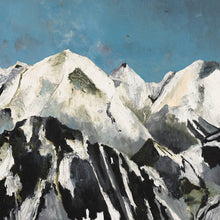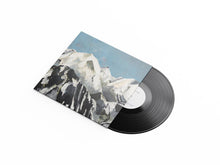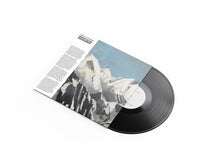Shelter Press / France / 2024 / LP
One of the universal experiences of life on Earth is staring, neck craned, at the cosmos. The vastness of one’s internal life meets the vastness of space, and in that moment those perspectives fuse in a state of wonder and curiosity. Space as an instrument, the new album by French artist and musician Félicia Atkinson, invites listeners to explore the phantasmic landscapes created in such transformative encounters, when the mind is open and receptive to its environment. Like being absorbed by the immensity of the night sky, this music dilates the imagination and helps us to sit comfortably in the mystery of the ineffable.
We are guided through Space as an instrument by the piano, its alinear story told through restrained, iterative melodies that become entwined with the sounds at the music’s margins - a wisp of electronics, a pinprick of an enunciated consonant. They were recorded on Atkinson’s phone, which was placed next to the keys, or behind her, with the sound of the room bleeding through to give a sense of the place and time of the encounter. She describes these sessions as meetings where she and the piano commune to co-create these spiraling phrases and vaporous dissonances moment by moment. Complicating this dynamic is the presence of digital pianos, which exist in the surreal space of diodes and LED displays. They act as avatars of their three-dimensional counterparts: nowhere and everywhere simultaneously.
Still, the inhabited world of people, water, and wind can be heard throughout Space as an instrument. Often these recordings are integrated into the backdrop of electronics, or reduced to the sound of movements whose physical forms are obscured: the microphone straining against a forceful gust on “Sorry,” arhythmic footsteps traversing an invisible terrain on “Pensées Magiques.” These field recordings take us to the brink of synesthetic experience, allowing us to glimpse with our ear the topography of the imagination. But Atkinson’s music resists any kind of singular perspective on the scene, or any distinct conclusion. “It doesn’t explain anything,” she says, “but it translates the way I perceive it, somehow.”
Atkinson is a polymath by nature, engrossed in a variety of daily artistic practices that nourish one another. In her garden, she performs the slow work of cross-species relationship building, cultivating an ideal space for introspection and further creation; many of the album’s vocal and electronic elements were recorded there. Poetry, which she prizes for its capacity to render the everyday tools of meaning-making more enigmatic, becomes folded into the music as well. She paints as often as time allows. One personal limitation Atkinson finds in painting, the rendering of perspective, has become one of her music’s defining characteristics. The vantage point of the listener is slippery and undefined, with sounds at once appearing gigantic and miniscule, distant and immediate.
This phenomena is central to “Thinking Iceberg,” a 13-minute piece that was whittled down from an hour and a half performance, who remain only a ghostly presence on the album’s recording. Atkinson wrote the piece in response to Olivier Remaud’s book ‘Thinking Like An Iceberg,’ in which the philosopher assigns agency to these massive, endangered objects and imagines how they might perceive their millenia-long relationship to humans. Stoic synthesizer tones percolate while water flows just out of the immediate frame with a disarming clarity and presence. As the piece crests, Atkinson’s whispered voice emerges softly, placed right against the listener’s left ear, contrasting with the billowing mass of sound that otherwise dominates. We emerge with a glimmer of awareness of how immensity and delicacy can coexist as time and humanity extract their toll.
Atkinson says her music exists “on the verge of understanding and not understanding,” which often precludes such literal interpretations. But in that nebulous space there is humility and openness, and perhaps enough empathy to understand the consciousness of a massive, frozen chunk of water. With the listener’s perspective diffused into many different vantage points, how might that, too, become a vehicle for the development of compassion? As we listen, we encounter the wisdom that there is meaning not just in the experience of the sublime, that radical juxtaposition of limitlessness and intimacy, but also in the continuum of countless individuals that have taken the same journey.
We are guided through Space as an instrument by the piano, its alinear story told through restrained, iterative melodies that become entwined with the sounds at the music’s margins - a wisp of electronics, a pinprick of an enunciated consonant. They were recorded on Atkinson’s phone, which was placed next to the keys, or behind her, with the sound of the room bleeding through to give a sense of the place and time of the encounter. She describes these sessions as meetings where she and the piano commune to co-create these spiraling phrases and vaporous dissonances moment by moment. Complicating this dynamic is the presence of digital pianos, which exist in the surreal space of diodes and LED displays. They act as avatars of their three-dimensional counterparts: nowhere and everywhere simultaneously.
Still, the inhabited world of people, water, and wind can be heard throughout Space as an instrument. Often these recordings are integrated into the backdrop of electronics, or reduced to the sound of movements whose physical forms are obscured: the microphone straining against a forceful gust on “Sorry,” arhythmic footsteps traversing an invisible terrain on “Pensées Magiques.” These field recordings take us to the brink of synesthetic experience, allowing us to glimpse with our ear the topography of the imagination. But Atkinson’s music resists any kind of singular perspective on the scene, or any distinct conclusion. “It doesn’t explain anything,” she says, “but it translates the way I perceive it, somehow.”
Atkinson is a polymath by nature, engrossed in a variety of daily artistic practices that nourish one another. In her garden, she performs the slow work of cross-species relationship building, cultivating an ideal space for introspection and further creation; many of the album’s vocal and electronic elements were recorded there. Poetry, which she prizes for its capacity to render the everyday tools of meaning-making more enigmatic, becomes folded into the music as well. She paints as often as time allows. One personal limitation Atkinson finds in painting, the rendering of perspective, has become one of her music’s defining characteristics. The vantage point of the listener is slippery and undefined, with sounds at once appearing gigantic and miniscule, distant and immediate.
This phenomena is central to “Thinking Iceberg,” a 13-minute piece that was whittled down from an hour and a half performance, who remain only a ghostly presence on the album’s recording. Atkinson wrote the piece in response to Olivier Remaud’s book ‘Thinking Like An Iceberg,’ in which the philosopher assigns agency to these massive, endangered objects and imagines how they might perceive their millenia-long relationship to humans. Stoic synthesizer tones percolate while water flows just out of the immediate frame with a disarming clarity and presence. As the piece crests, Atkinson’s whispered voice emerges softly, placed right against the listener’s left ear, contrasting with the billowing mass of sound that otherwise dominates. We emerge with a glimmer of awareness of how immensity and delicacy can coexist as time and humanity extract their toll.
Atkinson says her music exists “on the verge of understanding and not understanding,” which often precludes such literal interpretations. But in that nebulous space there is humility and openness, and perhaps enough empathy to understand the consciousness of a massive, frozen chunk of water. With the listener’s perspective diffused into many different vantage points, how might that, too, become a vehicle for the development of compassion? As we listen, we encounter the wisdom that there is meaning not just in the experience of the sublime, that radical juxtaposition of limitlessness and intimacy, but also in the continuum of countless individuals that have taken the same journey.
In truth there is nothing simple about The Flower & The Vessel. The album’s 11 songs span a vast pantheon of whispering textures, opaque moods, and surreal spoken word, leading the listener through a mirrored hall of beguiling mirages. Atkinson cites a trio of French classical compositions from her childhood as formative influences on this particular collection: Maurice Ravel’s “L'enfant et les sortilèges” (“a scary opera for kids”), Debussy’s “La Mer” (for its union of narration and music) and Erik Satie’s “Gymnopédies” (as an exercise in negative space, irony without cynicism, and “melody with doubt”). There’s certainly a shade of classicism woven within these tracks, however veiled, abstracted, or unorthodox. Melancholic piano motifs repeat then retreat into a radiant frost of shivering frequencies; processed voices recite cut-up poems and interviews over delay-refracted Rhodes and Wurlitzer; iPad gamelan patterns flutter from meditative to melancholic and back again, offset by pointillist patches of delicate software synesthesia.
Although much of Atkinson’s past discography is shaped by speech and the lyricism of language, The Flower & The Vessel ventures farther into silence, absence, and voiceless wilderness. Among her sources of inspiration were “women who wonder, dream, and create vacant spaces in their art,” as well as Ikebana flower arrangements, which reflect her own relationship with listening: “structure combined with everyday noises, selecting them to make a sparse music bouquet.” Field recordings from Tasmania and the Mojave Desert murmur beneath hushed reverberations of gong, vibraphone, marimba, softly processed into an elegant emptiness, alternately eerie and serene.
Her mode of minimalism has long been one of reduction, riddles, and curation, but here Atkinson’s synergy feels close to apotheosis, emotive but ambivalent, a ceremony of expectation and invisible forces. The 19-minute closing collaboration with SUNN O))) guitarist Stephen O’Malley, “Des Pierres,” is one of the album’s few pieces tracked in a proper studio (Music Unit in Montreuil, France) but it broods and burns with the same subliminal majesty as the rest of The Flower & The Vessel: an ember in amber, seeds planted in shifting sands. Atkinson’s voice flickers like a flame, framed by slabs of shadowy feedback. Her process may be personal is but its impact ripples to the edges of existence: “How does the act of creation connect us, not only to history, but to the cosmic? It’s a process of taking, and then giving back. It makes us belong to the world.”
Although much of Atkinson’s past discography is shaped by speech and the lyricism of language, The Flower & The Vessel ventures farther into silence, absence, and voiceless wilderness. Among her sources of inspiration were “women who wonder, dream, and create vacant spaces in their art,” as well as Ikebana flower arrangements, which reflect her own relationship with listening: “structure combined with everyday noises, selecting them to make a sparse music bouquet.” Field recordings from Tasmania and the Mojave Desert murmur beneath hushed reverberations of gong, vibraphone, marimba, softly processed into an elegant emptiness, alternately eerie and serene.
Her mode of minimalism has long been one of reduction, riddles, and curation, but here Atkinson’s synergy feels close to apotheosis, emotive but ambivalent, a ceremony of expectation and invisible forces. The 19-minute closing collaboration with SUNN O))) guitarist Stephen O’Malley, “Des Pierres,” is one of the album’s few pieces tracked in a proper studio (Music Unit in Montreuil, France) but it broods and burns with the same subliminal majesty as the rest of The Flower & The Vessel: an ember in amber, seeds planted in shifting sands. Atkinson’s voice flickers like a flame, framed by slabs of shadowy feedback. Her process may be personal is but its impact ripples to the edges of existence: “How does the act of creation connect us, not only to history, but to the cosmic? It’s a process of taking, and then giving back. It makes us belong to the world.”






